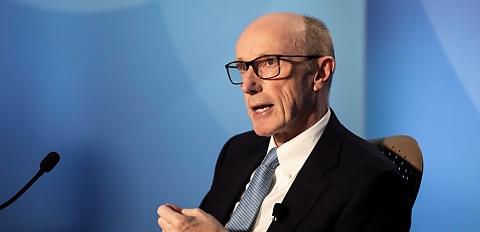Speaking at the Digital Finance Cooperative Research Centre (DFCRC) in Sydney (30 August), ANZ chair Paul O'Sullivan said innovation is occurring at a “faster and faster pace and will continue to do so”.
In addition, he said that DeFi, Web3, AI and new competitors will “radically disrupt our industry”.
The DRCRC is a 10-year, $180 million research program funded by industry partners, universities and the Australian government, which brings together stakeholders in fintech, industry, research and regulation.
It aims to develop and capitalise on the “huge commercial opportunities arising from the next transformation” of the financial markets.
Welcoming the establishment Mr O'Sullivan said ANZ looks “forward to being an active participant” in its projects alongside regulators, academia and industry groups.
“We might not know just how the future will evolve but we do know some… ventures will become very significant, even transformative, and we want to understand, participate and contribute where we can,” Mr O'Sullivan said.
“It will happen whether banks participate or not.”
Mr O'Sullivan said there was “great opportunity” for ANZ in areas such as digital trade finance, smart contracts, the Lygon digital guarantee company and, significantly, the interaction of digital assets and ESG.
“We take ESG very seriously. But not only is climate change an existential challenge for society it is also an enormous business opportunity for the finance community and banks like ANZ,” Mr O'Sullivan said.
However, he said it was not ANZ’s aim to “participate in everything taking place in the DeFi world” nor was it “necessarily for Australia”.
Indeed while in some mature markets overseas that don’t have robust payment systems, there tends to be some “extraordinary innovation”, there wasn’t necessarily that “need” in Australia, he said.
“For example, Australia already has a mature, innovative, reliable and digital payments and broader financial system,” Mr O'Sullivan said.
“By and large, the system and its governance work. Obviously we should constantly review but we don’t have glaring gaps.
“This is a point both the Australian Prudential Regulation Authority and the Reserve Bank of Australia have made.”
Looking ahead he said ANZ’s ability to “tokenise carbon credits” and offer a digital means of settlement, with our A$DC, was a “perfect example” of how it can participate.
“It’s a frontier opportunity that brings together our ESG ambitions, the carbon transition opportunity and our credibility as a licensed bank,” Mr O'Sullivan said.
“The carbon market is immature but it echoes the transition from manual, analogue banking to digital.”
While at the moment this emerging market lacks “liquidity, rules and clear market structures”, as well as the best market infrastructure, he said digital finance can alleviate some of these questions.
“Digital finance can address the ‘Market Infrastructure’ question by leveraging the benefits of asset tokenisation and distributed networks,” Mr O'Sullivan said.
“Since the sustainability markets are immature, the adoption of the most efficient and secure infrastructure is likely to accelerate the scaling, resilience and credibility of market operations.”
Futurist tips VOI to ‘fall by the wayside’
As the banking and finance industry aims to keep pace in the digital transformation era, futurist and co-inventor of 3D vector graphics VRML, Mark Pesce, said the increasing sophistication of identity fraud will result in the death of video and audio identity verification by the end of this decade.
Mr Pesce suggested that while the mortgage industry had quickly moved to adopt technologies such as e-signatures and remote VOI, there were still vulnerabilities in the process.
“Even that ability to be able to identify someone over a video — which is what my mortgage broker was doing with me last month — even that is going to fall by the wayside before this decade is over,” Mr Pesce said.
[Related: ANZ launches digital offering to market]

